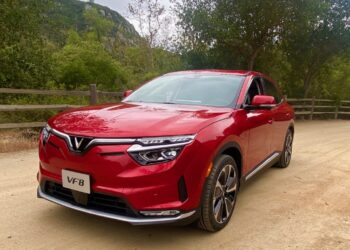EVgo
- A increase in electric cars and trucks would require large upgrades to charging infrastructure.
- A brand new research means that by 2035 some stations might want to present as a lot energy as a small city.
- As quickly as 2030, a typical charging station’s peak power utilization might rival that of a sports activities enviornment.
US roads are destined for an onslaught of electric vehicles, from SUVs and pickup trucks to delivery vans and semis.
However the nation’s charging infrastructure — and extra particularly the quantity of energy that stations are in a position to present — is not but as much as the duty.
A new study from the electrical energy and fuel utility Nationwide Grid (which serves components of New York and Massachussetts) means that by 2030, the standard passenger plaza alongside a freeway will demand as a lot energy as a sports activities enviornment throughout its busiest occasions.
By 2035, a bigger set up serving each passenger vehicles and vans may wish to supply 19 megawatts of peak energy, Nationwide Grid tasks, roughly what a small city makes use of. In 2045, that sort of truck cease could require 30 megawatts of capability, approaching the height utilization of a big industrial plant.

Nationwide Grid
Nationwide Grid estimated the longer term electrical energy demand at 71 potential charging websites, together with service plazas and truck stops, within the Northeast. It assumed that each one light-duty automotive gross sales will probably be electrical by 2035 and all medium-duty and heavy-duty gross sales will go the identical route by 2045, in keeping with Massachusetts’ and New York’s said targets.
At this time’s charging and gas stations aren’t outfitted to supply almost the quantity of energy that Nationwide Grid expects will probably be wanted by 2030, a lot much less 2045. Serving up 5 megawatts or extra sometimes requires main power-grid enhancements, the corporate stated.
The research’s authors argue that utilities and policymakers want to start out planning for upgrades now to fulfill the calls for of future highways — and keep away from stunting the EV transition.
It isn’t that this problem is insurmountable. Power and transportation consultants advised Insider that, with some sensible planning, utilities are capable of managing the coming EV wave.
Plus, these are early days. Teslas and different battery-powered fashions solely account for around 5% of new-car sales within the US. The world of electric trucking may be very a lot in its infancy.
However constructing out charging infrastructure takes time, and it pays to get forward of the curve, Nationwide Grid stated.
“Constructing these high-voltage interconnections and upgrades can take years, which is why it is necessary to take motion proper now,” it wrote in its report. “By making ‘no-regrets’ upgrades at ‘no-regrets’ websites, we will be sure fast-charging is there when drivers want it—and never a second too late.”







